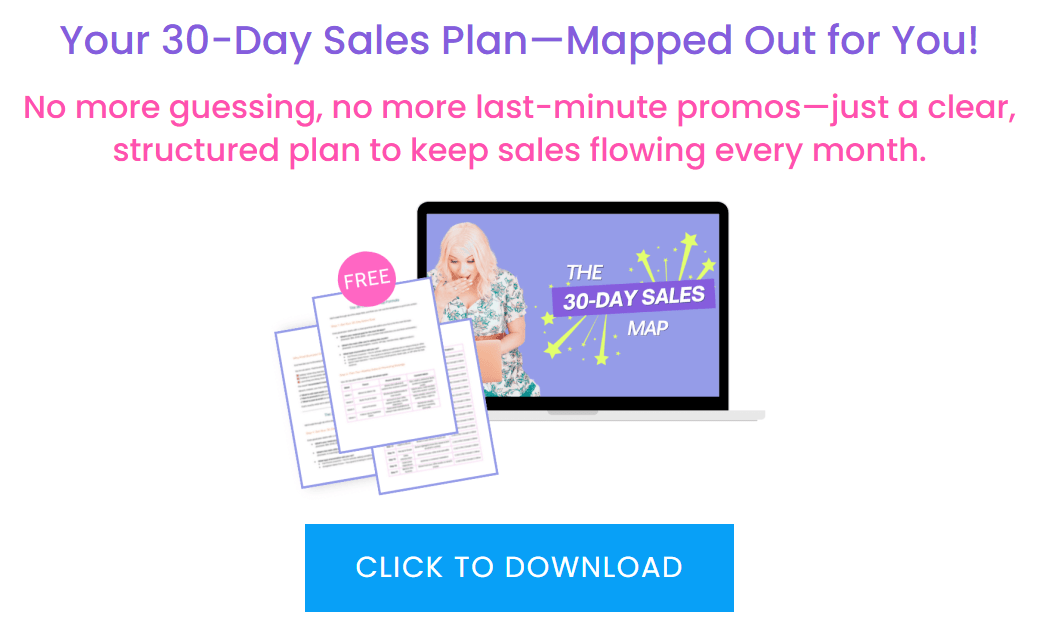Would you love to make your low ticket digital products more accessible and affordable—without sacrificing profit?
Or give your business a quick cash injection (without having to pitch on stories every day)?
Or even attract high-quality leads for your premium offers—while actually making money in the process instead of handing it all over to Meta?
Enter: Low ticket digital products.
If you’ve been looking for a way to bring in consistent, scalable sales without the constant hustle, low ticket digital products are the answer.
Even better? You can automate the entire process, so you’re making sales while you sleep.
In this guide, I’ll walk you through how to create, price, and sell a low ticket offer that runs on autopilot—so you can focus on growing your business (without working more).
Let’s dive in.
What Are Low Ticket Digital Products?
A low ticket digital product is an affordable, high-value product or service, typically priced at $97 or less.
- It solves a hyper-specific problem—making it an easy “yes” for buyers.
- It doesn’t require 1:1 fulfillment—which means you can sell at scale.
- It attracts buyers who are likely to invest in higher-ticket offers down the line.
Popular low ticket digital products include:
- Mini-courses (e.g., “How to Book Your First 5 Clients in 30 Days”)
- Ebooks or guides (e.g., “The 30-Day Content Plan for Coaches”)
- Templates, scripts, and toolkits (e.g., “Done-for-You Sales Page Copy”)
- Low-touch memberships (e.g., Monthly Q&A calls or resource libraries)
- Bundles that package multiple products together
The beauty of low ticket digital products is that they allow you to sell at volume—without adding extra work to your plate.
So how do you create one and turn it into a consistent revenue stream?
Let’s break it down.
Step 1: Identify Your Ideal Low Ticket Digital Product
Before you create anything, you need to answer one key question:
What’s a small but valuable result my audience desperately wants?
Your low ticket product should:
- Solve a specific problem, not a broad one.
- Be easy to implement, not overwhelming.
- Give buyers a quick win, not a long learning curve.
For example:
- A health coach might sell a 7-day meal plan instead of a full nutrition course.
- A business coach might offer a lead magnet template pack instead of a full-funnel strategy program.
- A marketing expert might sell a “30-Day Instagram Caption Pack” instead of an in-depth branding workshop.
Ultimately, your low ticket digital product should be a no-brainer purchase—something your audience sees and instantly thinks, I need that
Step 2: Price Your Digital Products for Profit
Now that you have your offer, let’s talk about pricing.
Most low ticket digital products fall between $7 and $97. However, the right price depends on your business goals and strategy.
Here are three common approaches:
Self-Liquidating Offer (SLO):
- Designed to cover ad costs so you acquire leads for free.
- Example: A $27 Canva template pack that offsets your Facebook ad spend.
Tripwire Offer:
- A low-cost, impulse-buy product designed to convert leads into buyers.
- Example: A $17 ebook that’s offered immediately after someone downloads a freebie.
Standalone Low Ticket Product:
- A main offer that generates ongoing, scalable income.
- Example: A $97 evergreen mini-course that sells daily via automated funnels.
By considering these factors, you’ll be able to price your offer for both profitability and scalability.
Step 3: Create an Automated Sales Funnel for Your Low Ticket Digital Product
Having a great product isn’t enough. You need a simple but strategic funnel that sells for you.
At a minimum, you’ll need:
- A high-converting sales page—that makes the offer an easy yes.
- An automated checkout process—so sales happen without manual work.
- A seamless delivery system—so customers receive their product instantly.
For even better results, consider adding:
- A thank-you page upsell—to boost your average order value.
- An email sequence—to nurture buyers and lead them to your next offer.
- An evergreen content strategy—so new people constantly find your offer.
When set up correctly, your funnel will work for you 24/7—bringing in daily sales and leads with minimal effort.
Step 4: Drive Traffic to Your Low Ticket Digital Products (Without Ads)
If you want consistent sales, you need consistent traffic.
The good news? You don’t need ads to make that happen.
Here are three organic ways to drive traffic to your low ticket digital product:
- Repurpose Content for SEO & Pinterest: Turn your best social media posts into evergreen content—like blog posts and Pinterest pins—that drive traffic daily.
- Leverage Strategic Partnerships: Collaborate with aligned entrepreneurs who can share your freebie and offer with their audience—helping you double or triple your reach without paid ads
- Use Your Email List: Nurture your subscribers with valuable content and strategically plug your offer. Email marketing is one of the highest-converting sales channels—so don’t sleep on it.
By focusing on these traffic methods, you’ll put your offer in front of the right people—every single day.
Step 5: Optimize & Scale Your Sales System
Once your low ticket digital product is selling consistently, it’s time to optimize for even bigger results.
Track key metrics like:
- Conversion rates—to tweak your sales page and increase buyers.
- Traffic sources—to double down on what’s working best.
- Customer behavior—to see what upsells or next steps make sense.
How do you scale even further?
- Test different price points to maximize revenue.
- Experiment with limited-time bonuses or bundles.
- Add upsells to increase customer lifetime value.
The more you optimize, the more effortless your sales become.
Ready to Make Daily Sales with Low Ticket Digital Products?
Low ticket digital products are one of the easiest ways to create predictable, scalable income—without adding extra client work to your plate.
They help you:
- Generate leads & sales on autopilot
- Create cash injections anytime you need them
- Attract buyers who are primed for higher-ticket offers
And the best part? Once your system is set up, it runs without you.
If you’ve been looking for a way to simplify sales, scale faster, and stop relying on launches—this is it.
Start building your low ticket digital product funnel today—and watch your business grow on autopilot.
Want a Simple, Done-for-You Plan to Sell More—Without the Guesswork?
If you’re ready to turn your low ticket digital product into a consistent sales machine, the next step is having a strategy that keeps sales flowing daily—without wondering what to post or when to sell.
That’s exactly why I created the 30-Day Sales Plan Map.
Inside, you’ll get:
✔️ A step-by-step roadmap so you know exactly what to sell and when.
✔️ Plug-and-play content & email prompts that turn leads into buyers.
✔️ A simple, structured plan to create predictable sales—without launching.
Ready to make selling effortless? Grab the FREE 30-Day Sales Plan Map now and start making daily sales on autopilot.








